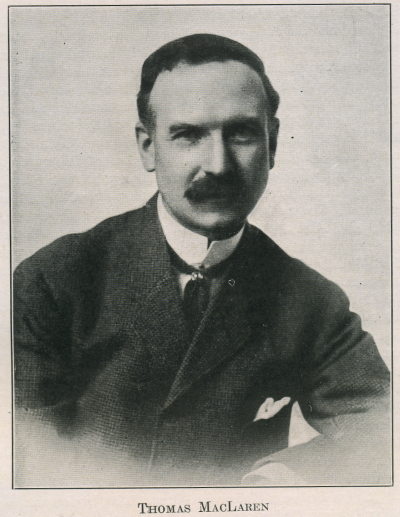
THE MacLarens are an old clan and
formerly had much influence in Lochearnside and Balquhidder. In the
so-called "Good old days," their attention was much given to wielding the
claymore against the MacGregors, their warlike neighbours. In these later
days, however, their energies find outlets in more peaceful fields. Since
Sir William Bruce of Kinross, Scotsmen have always held a high place as
architects, and Mr. Thomas MacLaren worthily upholds the spirit of the
work of the brothers Adam, Burn, Bryce, Thomson, and Norman Shaw, to
mention but a few prominent names.
Mr. MacLaren was born February 19,
1863, at Middleton, Thornhill, Parish of Kincardine, Perthshire, Scotland,
and is the youngest son of the late John MacLaren and Janet Downie. He was
educated in the public school, Thornhill, and the High School, Stirling.
In 1879, he entered the office of Messrs. Wallace & Flockhart, Architects,
London, and in 1882 was admitted as a student to the Royal Academy of
Arts, London. At the Royal Academy, in 1883, he was awarded First Silver
Medal for drawings of the Cloisters of Westminster Abbey, and in 1885, for
architectural design, was awarded the Gold Medal and Travelling
Studentship of £200, with which he studied on the European continent for
one year. In 1887, he was awarded, by the Royal Institute of British
Architects, the Pugin Travelling Studentship, with which he studied the
mediaeval architecture of Britain. His first work in the Royal Academy
Exhibition, Burlington House, was a drawing of the East Window of Melrose
Abbey, in 1885 (now in the possession of Lady Currie, Garth House,
Aberfeldy), and he exhibited there for several years afterwards. His
drawing of the Triforium of the South Transept of Westminster Abbey was
placed in the permanent collection of the Victoria and Albert Museum,
South Kensington, London, in 1911.
He opened an office in London on his
own account in 1888, and designed buildings both in Scotland and England,
also the interiors of several of the Castle Line steamships for the late
Sir Donald Currie, K.C.M.G., M.P.
In 1893, Mr. MacLaren came to
Colorado for his health, and since 1894 has been engaged in business in
Colorado Springs. Some of the buildings in that city designed by him are:
St. Stephen’s Church, Steele School, City Hall, Elks Club, Golf Club,
Broadmoor Casino, residence for Hon. John D. Long, and various work for
the late General W. J. Palmer. His design was selected in competition for
the Colorado Building at the St. Louis Exposition. In 1906, he entered
into a partnership with Mr. C. E. Thomas, which is still maintained. The
work of the firm includes: "Claremont," the residence of Mr. C. A.
Baldwin, Broadmoor (the exterior of which is modelled after the Grand
Trianon at Versailles, from studies made at Versailles by Mr. MacLaren),
Masonic Temple, Stratton Building, High School extension, Liller School,
etc., in Colorado Springs, and the following buildings in the state:
Congregational Church and Public Library, in Boulder; Masonic Temple, in
Montrose; Public Library, in Salida; Christ Church, in Canon City, etc.,
and a variety of work beyond the state.
Mr. MacLaren is favourably known in
the profession. He is a member of the American Institute of Architects and
of the Royal Institute of British Architects. He brought to his adopted
land not only high ideals of his art but a persistency of effort that have
won for him an established position.
As a patriotic Scot he is a member
of the Caledonian Society of Colorado Springs, of which he held the office
of Chief in 1911-12. He is a member of St. Stephen’s Church, of whose
beautiful structure he is the architect.
An elder brother, James M. MacLaren,
who died in 1890, was also an architect, the principal of his works being
an extension of the High School, Stirling, various buildings at Glenlyon
and Fortingall, Perthshire, residences at Palace Court, London, and
additions to Lianhydrock House, Cornwall.

